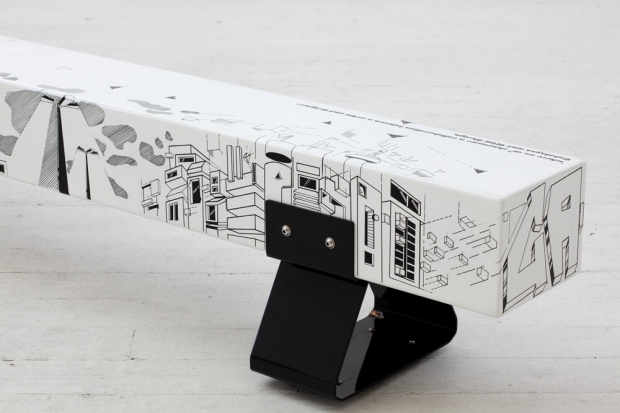„I always try to make things work, no matter what!“
„Africa is really rich, concerning the way people do things. We are more unorthodox than anybody around us“, says Atang Tshikare, part of a generation of young black designers and artists, who show the broad and energetic creativity of South Africa. He is on the way to not only pan-African but international reputation. QUER met him in Vienna, when he worked on his latest collaboration with Austrian designers like Breaded Escalope, Maciej Chmara from Chmara. Rosinke, Mostlikely and Valentin Vodev.
Nana N. Aiassi: You are labeled as one of the emerging creatives of South Africa. How does it feel to be called like that?
Atang Tshikare: For me „emerging creative“ started when I registered 2012 for Design Indaba, a national pavilion for up to 30 designers. Since then a lot of events and magazines still refer to me as an emerging creative, the only thing for me is I don’t know when emerging finishes! I have been invited to some really well-known design exhibitions, like 2013 to Design Days Dubai and 2014 to Design Miami. I think it‘s time to stand up a bit taller then.
With your growing reputation, you are offered additional jobs like being a judge at design events or holding lectures. Do you like these ad-on activities?
I think it‘s a good thing. In South Africa there is still a lot of enaquality that has been created by the past. These activities give me the chance to be one of the people to represent the other part, not being represented in South Africa so far.The country is only 20 years into democracy South Africa is still very divided with lots of things, the representation is not o.k. in many ways. It‘s nice to be in a position like this where you are like a minority in terms of design, but in terms of ethnicity or race you are part of the majority that is not represented. I try to represent the best that I can.
Your brand „Zabalazaa“ means resist or struggle, why did you choose this unusual name?
Zabalaza is a very broad term in South Africa, we have 12 official languages and „zabalaza“ can be used in most of these languages, so it applies to a lot of people.
Zabalaza meant in the 1970ies and 1980ies resistence against either government or negative things. In the 1990ies, it also was used when you are doing something until you get it. There even is a secret in the spelling as I put an extra „A“ at the end: Zabalazaa. I put in the extra push in my work. I always try to make things work, no matter what!
With Zabalazaa I really want to prove that I can do something, not just me, but also show how people can work together. Most of my work are actually collaborations, I have done more than 20 collaborations in the past 3 years. Sometimes they call me the „King of collaborations“.
You started your career with customizing sneakers for Adidas. How did you connect with companies such as Adidas, Puma and L’Oréal?
2006 I went to the UK and there I was customizing shoes, because in South Africa we don’t have such a variety of shoes and products – shoes with animal prints and fur and all these fancy things. So I started buying and customizing shoes, I was crazy this time. Two years later in Cape Town, I started to sell in a shop, serving customers, not having to do anything with design, but I was almost like Wikipedia for shoes. The store manager really knew that I had a passion and a talent for shoes and handed on this to the Managing Director of Adidas. I invited him for lunch and I brought all the magazines where I was featured in and in one magazine I was wearing Nike shoes. He said: „Hey, why don’t you wear Adidas?“ I said: „I can wear whatever I want, because I am not sponsored. I don´t really care about Adidas, I care about style and aesthetics.“ So that’s how I got sponsored by Adidas for a year.
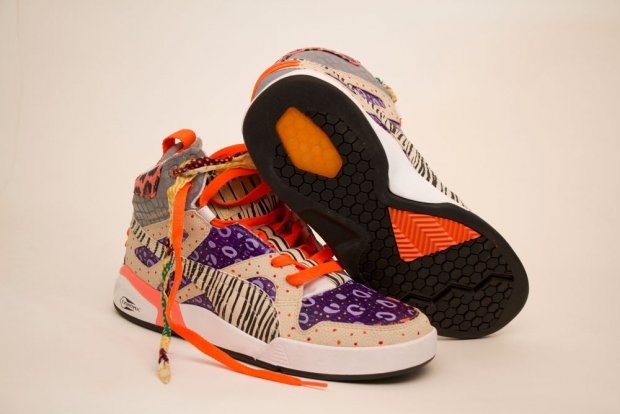
Meanwhile you do a great variety of jobs, you work as a graphic designer, graffiti artist, you do wallpapers, ceramics, wooden figures, you customize bicycles. Are there projects or works that are closer to your heart than others?
I like things that are multifunctional. I started customizing bicycles, which has a couple of advantages: a) It looks good b) It also protects me, because if someone sees a specific bike and tomorrow it’s stolen, then you have a memory with it.
I was in Berlin at a friends place, having a party. The house was really small like in South-Africa. There was this small coffee-table and I kept bumping my leg 3 times until I thought: „Hey, this is really bad, I want to throw it out of the window. But instead of throwing it out of the window, it could be on the wall.“ Then I designed a table, where the legs fold inside with minimal mechanics and very light wood and there is a design, that I put on the top, which is almost like my architectural style, so you can look at it in different directions. So in terms of functionality I like to have things that are multifunctional, Working on these projects is definitely closer to my heart.
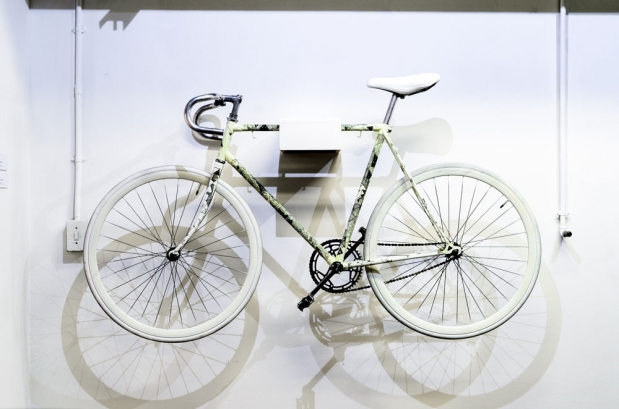
There is no future without heritage, this also applies to design. How much does your heritage influence your work?
Now even more than before! You think about where you are from, what you have, what you don’t have and what you would like to have. The better you know where you are from, the better you know where to go. So that’s why I will continue to work more with people from South Africa. And when working with people from abroad I really want to come back and see what I haven’t discovered before, and then take the things I know as an African and ad a bit of that taste and end-up having that bit of international flair.
For example when I met the guys from Mostlikely, they make a lot of different things in 3D and now I collaborate with them: They are making the Big Five as tiny figures. So this is how it works: I am taking the stuff I know from South Africa and work together with someone working in 3D. So everything comes back to heritage.
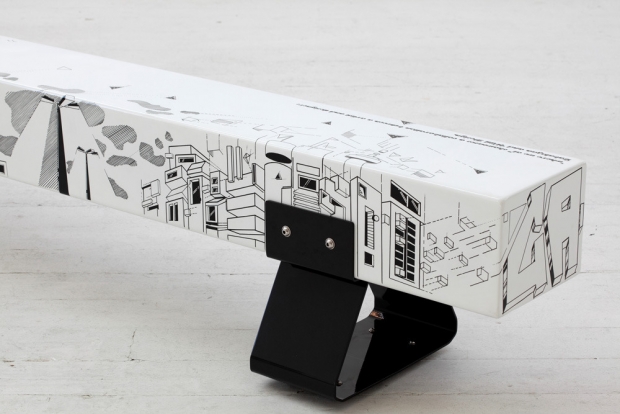
So that’s one of the future projects with Austrian designers?
Yes, and these collaborations make sense.
There are things in South Africa you can’t find anywhere else and they tell you about the history of this place. I use these things who are uniqly South African and then you can create something that is your own unique art work. You should always have a reason for doing something, then it makes more sense for you, you remember it more and can relate to and you can say: „Hey I have got this art work and that’s where it comes from and this is the story.“
I would like to be provocative – Can Africa, the South rescue Europe, the North in terms of creativity, sustainability, social design?
Collaboration is good, because you meet up with someone who is totally not in your state of mind. My first collaboration was with an Africaans guy, as an Africaans in the 1980ies a black designer was the last person you wanted to work with! The other collaboration was with a lady who does fashion. In the interview she explained what fashion is and what style is and I totally changed my mind-set and my opinion about fashion. So when I go to certain trips like to Miami, she makes special pants and knows I am the only person brave enough to wear this. It’s about finding the common ground.
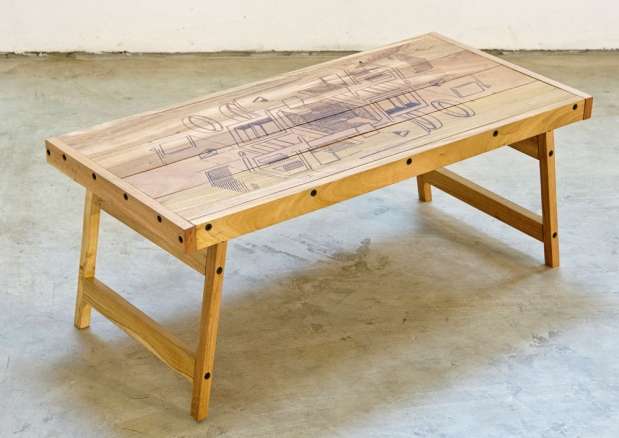
How much do events like „World Design Capital“ push the general awareness of design?
People not working in the design field did not know so much about it, so you had to go and tell your friends: I do design.
When I look how many more friends of mine came to me this year and ask me how it is to be at Design Indaba , then I really see how it makes a difference. Activities like Southern Guild, Guild and Design Indaba push the awareness. Not just in Cape Town, but even in Johannesburg as well design events and festivals come up. I can even see financially how it works. Last year I was barely paying my rent and now I can pay next moth without even looking, I am employing now the second person next month and I am seeing this influence. Now I don’t have to justify my prices anymore, they know my work, I have been to Design Miami and if Atang goes to a thing like this it must mean there is a bigger world out there.
In the past 3 years a lot has happened in your life. If you take a look into the future ...
One of my favorite sayings is: Fantasy is the beginning of success. So if you fantasize about something you want, you start chasing life and that’s what it is about.
I remember when I was the first time in Cape Town, I haven’t been on an airplane for 10 or 15 years. The only time was when my mother took me from Bloemfontein to Cape Town and I thought the next time I am on an airplane I want someone else to pay for it and wants me to do an art work. That was when Adidas took me from Cape Town to Johannesburg: When I was sitting in the plane I was realizing: „Hey, this is happening!“.
Every time you fantasize, you put in your consciousness what you want, you think
about it, you dream about it, and then you make it into reality! You can teach people how to fantasize what they really want! That’s what I am talking about, you end up finding a way.
Is there any question I didn’t ask but should have asked?
Maybe the question, why a lot of „Food for thought“ in the future will come from Africa and its people?
Africa is really rich, culturally, historically and concerning the way people do things. I am planning more trips within Africa, also to document that. I think what we should do is a lot of documenting, so that by the time we are 150 years from now we have a splendor of works, something similar to MAK Museum. Most of our stories are told orally. There is a saying in Africa: If an old person dies it’s like a library has been burnt and at the same time people say that’s nonsense, because if it is a stupid old person, there is no library.
This is one of the great things about South Africa or even Africa: We are more unorthodox than anybody around us. We don’t go with the books because we have to. That’s why my business is called Zabalazaa, because I am not going to wait for government. You go there, you make things happen! If you always wait for someone to give you the right orders, then you always end up to be the last one in the line.
Sometimes, I am not a gentleman but an African man.
Find out omore about Atang Tshikare at www.zabalazaa.com

